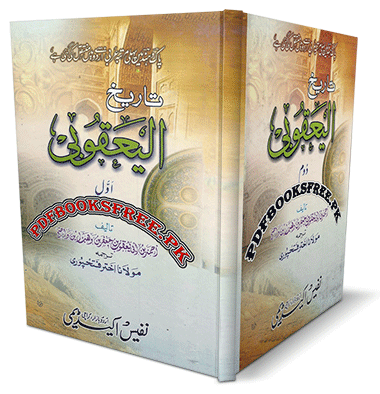Tareekh e Yaqoobi Urdu by Ahmed Bin Abi Yaqoob Pdf Free Download
Tareekh e Yaqoobi is an authentic and comprehensive Islamic history that describes history from Prophet Adam to 872, i.e., the time of the eighteenth caliph of the Abbasid Caliphate. The original book is in Arabic and translated into Urdu by the famous translator and scholar Maulana Akhtar Fateh Puri.
Islamic history is a spiritual subject, which began to be written from the earliest days of Islam, continues to this day, and will continue to do so in the future. Books on Islamic history were first documented in Arabic and then translated into various languages, and later on, in English and Urdu. In addition to popular languages, Islamic history has also been written in Chinese, Japanese, French, Russian, Persian, Turkish, Hindi, Bengali, Marathi, Sindhi, Balochi, Pashto, Punjabi, and many other national and regional languages of the world.
The Muslims first started writing on Islamic history, but since then, scholars of every religion have experimented on the subject. Some scholars have described the biography of the Holy Prophet (PBUH), and some have highlighted the aspects of Islamic battles and Jihad. Some writers clarified the corrective and moral point of the true religion, and some have made its teaching parts subject of thought. Some historians provide details of the hadith’s narrators, while others discuss the preaching of Islam. Some writers praised various aspects of Islam, and some criticized it. Everyone has their style of expression, study, thinking, and way of speaking. We want to introduce the “Tarikh-ul-Yaqubi” book in many books on the subject. The author of this book is Ahmad bin Abi Yaqub bin Jafar bin Wahib bin Wadih Al-Katib Al-Abbasi, known as Yaqubi.
Yaqubi was a well-known historian, geographer, and writer of the Abbasi era. His father was a descendant of “Wadih,” a freed slave of Caliph Mansour Abbasi, and for this reason, the family was called Abbasi. After the fall of the Tahirid dynasty, Yaqubi went to Egypt. There, in 891, he wrote “Kitab al-Buldan” a geography book. He wrote Kitab al-Baldan after reading various books and getting information from multiple tourists. He begins by describing Baghdad and Samarra and then describes Iran, Turan, and northern Afghanistan. It also contains information about Kufa and Western Arabia.
Yaqubi is a careful writer in describing events. What he writes is concise but comprehensive. In this respect, “Tareekh e Yaqoobi” is one of his most important books and contains a Treasury of information. Yaqubi died in the year 897.
The book “Tareekh e Yaqoobi” is divided into two volumes, and the second volume is almost twice as thick as the first volume. The first volume begins with Hazrat Adam. Then there is the mention of the Prophets of the “Bani Israel” up to Prophet Isa a.s. The disciples of Prophet Isa are also mentioned in this book. Then there is the story of the Syriac kings, the rulers of Mosul and Nineveh, then the kings of Babylon, followed by the Indians, the Greeks, and the northern nations.
The second volume of the book begins with the birth of the Holy Prophet and contains the Islamic history up to 872 AD. Since Yaqubi was also interested in astronomy, he also drew a map of the constellations and planets at the beginning of the period of government which he mentions. The book is fascinating in terms of content and articles and contains a lot of information. The great thing about the author is that he has organized the whole history up to his time in a neat and simple style.
The author Ahmed bin Yaqub is a broad-minded historian and is aware of the conditions of all the countries of his time. He is also aware of their religious and social affairs. About India, which includes Pakistan and Bangladesh in terms of current geography, he writes that it is a country of Brahmins, and these people are its absolute rulers. These people are idolaters and scattered in different parts of this vast country. Although people live here besides Brahmins, he claims that these are the most respected people and all the other people are inferior and backward compared to them.
According to Yaqubi’s research, the first king of the Indian kings whose every word was acknowledged was a Brahmin, and he was the first to express his views on astrology in this area. Apart from India, he also mentions Sindh in the book. This chapter of the book is especially interesting for the readers of the subcontinent.
After India, Yaqubi recorded the history of the Greeks. In the beginning, there are some essential details about Greek physicians and philosophers and their services on various topics, highlighting their efforts in medicine, mathematics, astronomy, instruments, etc. What the Greek philosophers and physicians wrote and how they did it are explained. At the same time, Yaqubi also mentions the scholarly activities of Greek physicians and philosophers like Hippocrates, Pythagoras, Plato, and Socrates. It also contains the mutual discussions of some scholars on various topics. This chapter covered the whole scientific work of the ancient Greek philosophers.
Then there is the detail of the Greek and Roman empires. The author states that the king of the Greeks was a descendant of Javan bin Japheth bin Noah. Among his descendants was King Alexander, who is called Zulqarnain. The author states that Alexander was a king of sharp mind, high thought, and glory. Before he came to power, the kings of Greece considered themselves inferior and paid taxes to the kings of Babylon, who belonged to Persia.
The author has written in detail about the “Ashab e Kahf” mentioned in the Quran and recorded their name and dog’s name. Although the author has written this incident briefly, the whole incident is comprehensively described.
Then comes the “Kingdom of Persia,” which mentions the kings of Persia, i.e., Iran. These kings include Tahmurath, Jamshad, Zothamasib, Kaykhusraw, Kayqubad, and Kaikaus, the first king of Persia. Then there are mentions of other kings, including Sabur bin Ardashir, Bahram bin Maharmaz, Bahram bin Bahram, Hormuz bin Farsi, Yazdegerd, Feroz, Anushrwan, and many others. Like other chapters of the book, this chapter also covers much information.
The next chapter describes information about China and other parts of the region, its rivers, and islands, and identifies their festivals, customs, and culture. In this part of the book, the kings of Egypt and the rulers of Coptic are also mentioned. Berber, Abyssinia, Sudan, Yemen, Sham, and Hadramaut are also described in exciting and simple words.
The book also mentions the descendants of Ishmael and his different tribes and races. Then the religions of the Arabs, their rulers and emperors, their annual festivals, their trade markets, their bazaars, their poets, and their writers are mentioned. The customs and manners of Arabs, their civilization, and their culture are beautifully quoted.
In the first volume of the book, which contains the above titles, the events of each country and era are described so that the reader feels that all those events and situations are happening before him, and he is watching every event with his own eyes.
Now, let’s move on to the second volume of the book. This volume begins with the birth of the Holy Prophet (PBUH) and describes His date of birth, childhood, and all-important events of His youth which He has been associated with in one way or another.
The beginning of the revelation of the Qur’an, the event of Miraj, the migration to Abyssinia, the migration to Medina, the ruling on the obligation of prayer and fasting, the events of Ghazwa e Badr, Uhud, Khandaq, Sulah Hudaibiya, Fatah e Khyber, Fatah e Makkah, Ghazwa e Hunain, and Battle of Mutah have been narrated. The presence of Arab delegations in the service of the Prophet (PBUH). The letters He wrote to various kings and rulers of the world and invited them to accept Islam. The wives of the Holy Prophet (PBUH), His sermons, advice and moral teachings, Hujjat-ul-Wida ‘and all the events up to His death have been written. These events consist of hundreds of pages in the book.
This is followed by the caliphate of Abu Bakr and the events that took place during his reign. Then the caliphate of Umar Farooq and his conquests are mentioned. After Hazrat Umar Farooq comes the era of Hazrat Uthman. After his martyrdom, there is mention of the caliphate of Hazrat Ali. Beyond this, the caliphate of Hazrat Hassan and then the caliphate of Hazrat Muawiyah begins. After his death, Yazid’s government comes, in which the tragedy of the martyrdom of Hazrat Hussain takes place. Later the details of the rulers of the Umayyad dynasty are given.
From 132 AH, the reins of the Islamic government fell into the hands of the Abbasi family. The author mentions eighteen rulers of this dynasty. The eighteenth Abbasid ruler of his time was Ahmad Al-Muttamid Ali Allah, who succeeded to the throne on 14 Rajab 256 AH. The events in the book are narrated in chronological order, and the author has written down the circumstances up to 259 AH.
The need for an Urdu translation of the book was being felt. This task has been performed by the famous translator and scholar Maulana Akhtar Fateh Puri. The language of Urdu translation is clear and fluent. The translator has served Islamic history by translating this book and also making significant additions to the Urdu language and literature. Reading the book will prove to be helpful for the readers.
The book “Tareekh e Yaqoobi” in Urdu translation is now available in Pakistan virtual library in a high-quality Pdf document for the study of our visitors. Check out the following links to read online or download the complete book in Pdf format and enjoy offline reading on your computer and smartphone.

